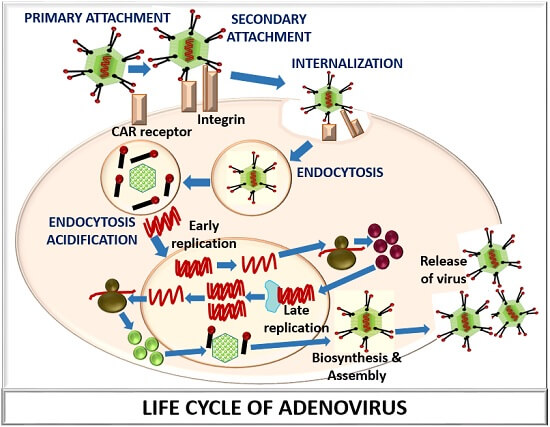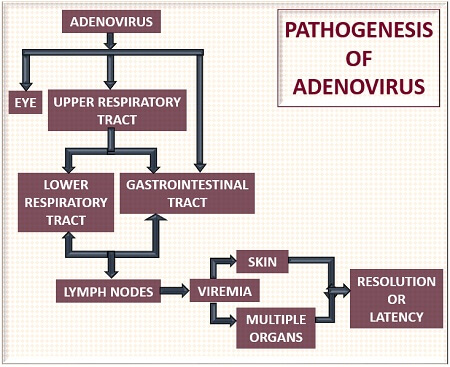The life cycle of adenovirus has different stages like attachment, internalization, uncoating, replication, biosynthesis, assembly and release of viral progenies. After lysing the host cell, they infect new cells and cause infections either for the short term or long term. Adenovirus mainly causes four kinds of infection like a productive, abortive, latent and oncogenic infection.
The life cycle of adenovirus involves three major stages (like infection, replication and multiplication). At the time of infection, adenovirus enters the host cell via cell-mediated receptors and through the process of endocytosis. The adenovirus replication occurs within the host cell nucleus, where it produces copies of viral progenies by hijacking the host cell machinery.
The multiplication stage of adenovirus mainly involves the early and late phase that produces early and late gene products, respectively. The early and late gene products help in the regulation and synthesis of virion’s structural components. After multiplication, the viral particles assemble and eventually release from the host cell by causing cell death or budding.
Adenovirus may infect the host cells via respiratory droplets, close contact and faecal-oral route. After entering the host cell, a virus first attacks the mucoepithelial cells. Later, it causes direct cell damage of an eye, gastrointestinal tract, upper and lower respiratory tract.
Later, it infects the preauricular, mesenteric and cervical lymph nodes and sometimes the infection also spreads to the visceral organs. In this context, we will discuss the different stages in the life cycle of adenovirus and its multiplication mechanism and interaction with the host cell.
Content: Life Cycle of Adenovirus
Stages in Adenovirus Life Cycle
The life cycle of adenovirus can be summarized in the following stages:

Attachment
Adenovirus gets attached to the host cell surface by two-stage interactions, namely:
- Initial interaction
- Secondary interaction
Initial interaction: In this stage, the attachment of penton fibre occurs with the host cell receptor. A knob of the fibre protein attaches with the CAR family’s cell receptors (Coxsackievirus Adenovirus Receptor). CD46 is the most common receptor for all the serotypes of adenovirus. The host cell also possesses receptors like MHC-I, MHC-II molecules and sialic acid residues.
Secondary interaction: Attachment of the penton base occurs with the host cell’s αV integrin protein during the secondary interaction or co-receptor interaction.
Internalization
There is a special motif in the adenovirus structure called the “Arginine glycine aspartate motif ”. The configuration of the arginine glycine aspartate motif helps an adenovirus to get internalized into the host cell. The process of internalization is very specific or selective. The αV integrin protein gives a signal for the particular serotype of the virus and results in the induction of actin polymerase to uptake the virus.
Endocytosis
It merely refers to the process of adenovirus internalization by the host cell membrane into the cytoplasm. The arginine glycine aspartate motif of the penton base associates with the host cell’s αV integrin protein and results in adenovirus endocytosis. A process of endocytosis or “receptor-mediated endocytosis” occurs through CCPs (Clathrin coated pits) of the host cell membrane.
Vesicle Formation: When the adenovirus enters the host cell, a vesicle forms around it and called “Endosome”. This is a unique feature, where the whole virus gets into the host cell cytoplasm rather than the genetic material.
Viral Uncoating
The virion gets released from the endosome as a result of endosome acidification. The endosome’s acidification results in a dissociation of the protein particles like fibre and capsid into the cytoplasm. Only the viral DNA moves into the host cell’s nucleus for the process of replication and multiplication.
Replication and Biosynthesis
The viral DNA replicates inside the nucleus. A 55 KD terminal protein acts as a primer and attaches with each 5’ end of the viral ds-DNA. This terminal protein initiates the synthesis of viral DNA. In adenovirus, two kinds of replication mainly occur:
- An early phase of DNA replication
- The late phase of DNA replication
The early phase of DNA replication occurs inside the nucleus, which will produce the early genes. The early gene products will undergo transcription to produce early viral mRNA and move to the host cell cytoplasm. A viral mRNA will further undergo translation and produce the early viral regulatory proteins. Early viral protein brings the S-phase of the host cell.
The late phase of DNA replication occurs inside the nucleus, which will produce the late genes. The late gene products will undergo transcription to produce late viral mRNA in the host cell cytoplasm. A viral mRNA will further undergo translation and form the late viral structural proteins.
Bioassembly and Release
After the adenovirus gene expression or the completion of the mRNA translation, all the virion proteins or particles get assembled. The viral DNA is first packaged into the capsid along with penton fibres, and the process called “Maturation”. The mature viral progenies finally leave the host cell either through budding or cell lysis and later infect other cells.
Multiplication
The adenovirus primarily infects the epithelial cells of the respiratory tract, urinary tract, intestinal tract and lining of the eyes. When it finds a specific host cell, it replicates and undergoes multiplication in the epithelial cells of the conjunctiva, cornea, pharynx etc.
After infecting the epithelial cells, it can further spread to an infected person’s regional lymph nodes. Usually, an adenovirus infection does not spread beyond the regional lymph nodes but can also affect visceral organs in some cases.

Host cell and Virus Interaction
Viral progenies release out of the host cell and mainly produce the following types of infection with the host cell:
Productive infection
It is also called “Lytic infection”. Productive infection can define as the type of infection where the viral genome undergoes complete replication and causes cell death by releasing viral progenies. Symptoms start appearing after a few days of infection.
Abortive infection
It can define as a form of infection where the viral genome undergoes incomplete replication. Thus, a virus is unable to produce viral progenies in abortive infection, but the infection remains persistent to the host cell.
Latent infection
It is a type of infection in which the virus particles remain inside the host cells or tissues. In latent infection, the virus particles persist in a latent or hidden form, but the symptoms appear once the host cell’s immunity or resistance becomes low.
Oncogenic transformation
One of the unique features of adenovirus is its oncogenic property. Some serotypes like A and B can transform the host cell into the cancerous cell after viral DNA integration.
Some of the adenovirus infections are mild and self-limiting.